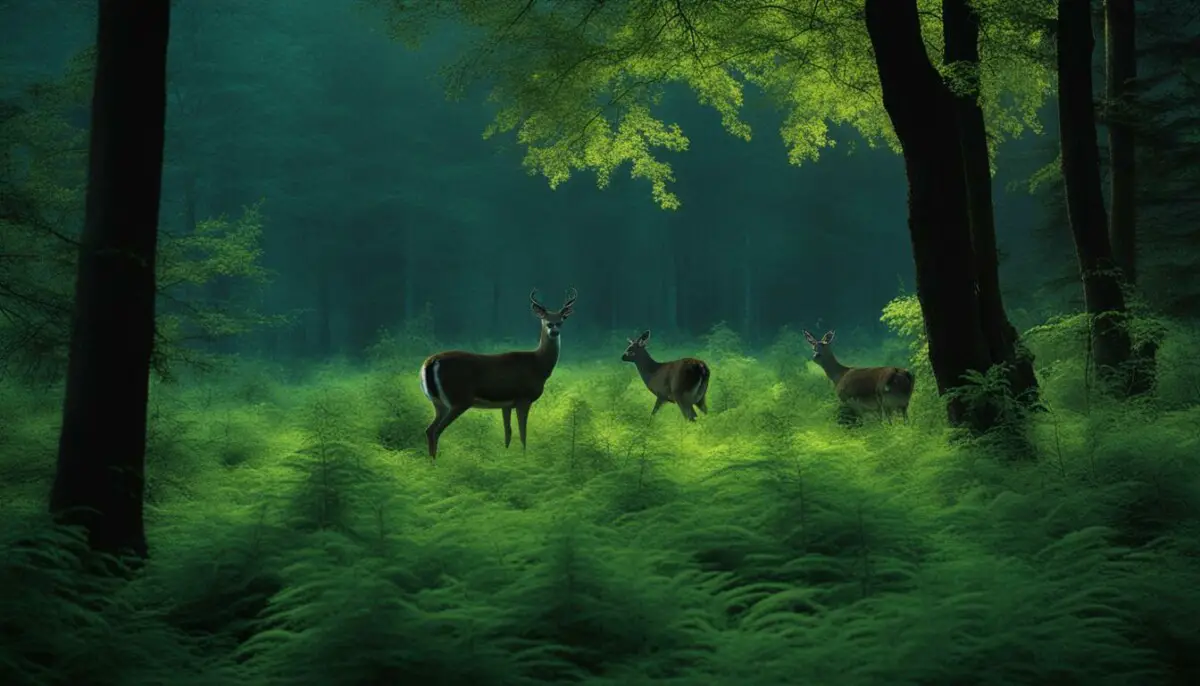Last Updated on 6 months by Francis
Have you ever wondered if deer can see infrared light? As one of nature’s most fascinating creatures, deer have long captivated humans with their elusive behavior and impressive adaptations. With their keen senses and natural instincts, deer have developed unique abilities to navigate their environment, including their visual perception of light. In this article, we explore the question of whether deer can see infrared light and examine the intricacies of their visual perception.
Contents
Key Takeaways:
- Deer have a unique visual system that allows them to perceive specific wavelengths of light.
- Infrared light falls outside the range of wavelengths that deer can typically perceive.
- While there is ongoing research on the topic, current evidence suggests that deer likely do not have the ability to see infrared light.
- Other factors, such as the structure of a deer’s eye and environmental conditions, can also impact their visual perception.
- Advancements in technology have allowed researchers to study wildlife vision in unprecedented detail and shed new light on the nuances of deer perception.
Understanding Deer Vision
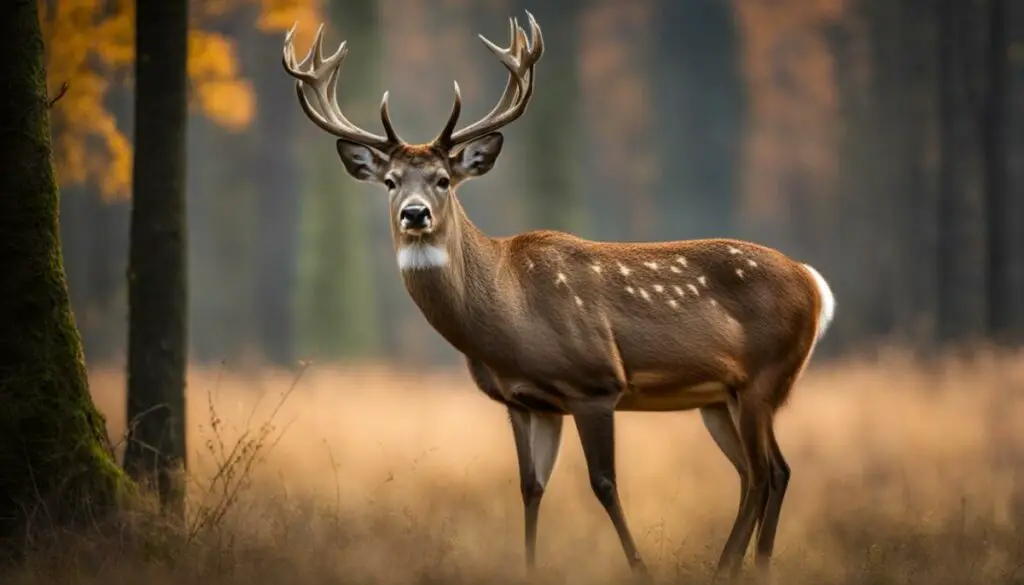
Deer, like many other animals, have a unique visual system that enables them to perceive the world in a way that is quite different from humans. To understand their vision, we must first examine the light spectrum that deer can perceive.
Deer can see a range of wavelengths, including those in the visible light spectrum and some in the ultraviolet range. However, their visual perception of different wavelengths differs from that of humans. For example, deer are much more sensitive to blue light and less sensitive to red light than humans.
| Wavelength (nm) | Human | Deer |
|---|---|---|
| 400-480 | Blue light | Most sensitive |
| 480-500 | Cyan light | |
| 500-565 | Green light | Sensitive |
| 565-590 | Yellow light | |
| 590-625 | Orange light | |
| 625-700 | Red light | Least sensitive |
It’s important to note that the sensitivity of deer vision to different wavelengths varies depending on various factors, such as the time of day and the season. For example, during the autumn rut season, deer vision shifts towards the blue end of the spectrum, possibly to aid in the detection of other deer.
Another key aspect of deer vision is their binocular vision. Unlike humans, who have binocular vision in the center of their visual field, deer have a much wider binocular field, which helps them detect predators and other threats in their environment.
So, while deer can see a range of wavelengths in the light spectrum, their visual perception of different colors and their binocular vision differs from that of humans. This is a crucial foundation for understanding whether deer can see infrared light, which we explore in the next section.
Exploring Infrared Light
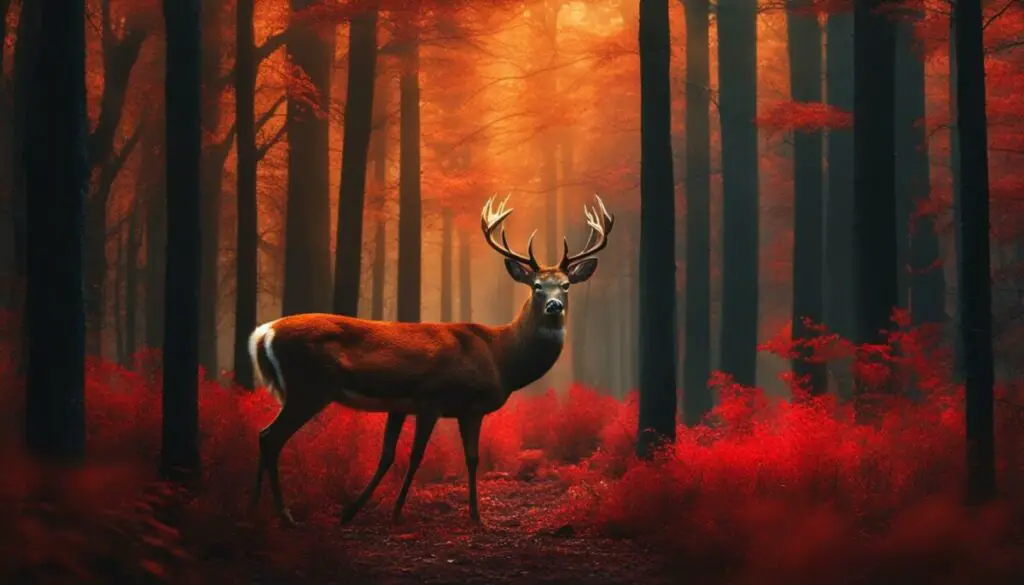
Before we can determine whether deer can see infrared light, let’s first understand what infrared light is and how it interacts with the visual system of deer. Infrared light is a part of the light spectrum with wavelengths longer than visible light, which means it cannot be perceived by the human eye. However, some animals have evolved to detect and use this part of the spectrum for various purposes, such as seeing in the dark.
Infrared light can affect deer vision in a few ways. For example, it can impact the way they see their surroundings, as objects may appear differently under infrared light than they do under visible light. Additionally, infrared light can interfere with other visual cues, such as shadows and reflections, which deer may rely on to detect predators and navigate their environment.
Some studies have suggested that infrared light does have an effect on deer vision. Research shows that deer are more sensitive to short-wavelength light, such as blue light, rather than long-wavelength light, such as red light. This suggests that deer may not be able to see infrared light as well as they can see other types of light.
To better understand how infrared light interacts with deer vision, let’s take a closer look at the visual system of deer. Deer have eyes that are adapted to see well in low-light conditions, but they have a different structure than human eyes. Their eyes have a larger surface area and more rod cells, which are specialized cells that help detect light. They also have a tapetum lucidum, a reflective layer behind the retina that reflects light back through the retina to enhance vision in low-light conditions.
Despite these adaptations, it is still unclear whether or not deer can see infrared light. Some studies have suggested that they may be able to detect some infrared wavelengths, while others have found no evidence of this ability. More research is needed to fully understand the nuances of deer vision and their potential to perceive infrared light.
The Science Behind Infrared Light Detection
Scientific studies have been conducted to determine whether deer possess the ability to detect infrared light. These studies have focused on the structure and function of the deer’s eyes and their response to varying wavelengths of light.
One key study conducted by researchers at the University of Georgia found that while deer do have some limited ability to detect infrared light, it is not a significant part of their visual system. The study measured the electrical signals from the eyes of white-tailed deer in response to different wavelengths of light. The results showed that while the deer’s eyes did respond to near-infrared light, the response was much weaker than to other wavelengths of light, such as green and blue.
Another study published in the “Journal of Mammalogy” measured the spectral sensitivity of the eyes of mule deer and found that their visual system is most sensitive to blue and green light, with little sensitivity to red or near-infrared light.
These studies suggest that while deer may have some limited ability to detect infrared light, it is not a significant part of their visual perception. Other visual cues, such as contrast and movement, are likely more important in the deer’s visual environment.
The Limitations of Deer Vision
While there is evidence to suggest that deer may have some level of visual perception in the infrared spectrum, it’s important to consider the limitations of their vision when interpreting this information.
The structure of a deer’s eye is similar to that of a human’s, with a lens and retina that work together to form an image. However, there are several factors that can impact their visual perception, including the presence of other visual cues in their environment and the angle and direction of the light source.
One study found that deer are less sensitive to short wavelengths of light, which may affect their ability to detect blue and violet light. This could potentially impact their ability to see infrared light, as it falls at the shorter end of the light spectrum.
Additionally, deer are known to rely heavily on their sense of smell and hearing, which may take priority over their vision in certain situations. For example, in low-light conditions, a deer may rely on scent and sound cues to detect potential predators.
Overall, while it’s possible that deer may have some level of infrared light perception, there are several limitations to their vision that must be considered before drawing any definitive conclusions.
Infrared Light Adaptation in Wildlife

While there is no conclusive evidence to suggest that deer can see infrared light, some nocturnal animals have adapted to utilize this part of the electromagnetic spectrum for enhanced vision in low-light conditions.
The common vampire bat, for example, has specialized infrared sensors in its nose that allow it to detect the heat signatures of prey. Similarly, pit vipers possess heat-detecting pits on their faces that enable them to locate warm-blooded animals in the dark.
While there is no evidence that deer possess similar adaptations, it’s worth noting that these nocturnal animals have evolved to fill specific ecological niches. Therefore, the absence of infrared sensors in deer doesn’t necessarily mean that they are incapable of perceiving this part of the light spectrum.
“These nocturnal animals have evolved to fill specific ecological niches.”
It’s possible that future research may uncover hitherto unknown mechanisms by which deer can perceive infrared light. Alternatively, it may find that deer possess other adaptations that enable them to navigate their environment in low-light conditions.
Until more is known, we can only speculate about the mysteries of deer vision and the potential role of infrared light in their world.
Field Observations and Anecdotal Evidence

Field observations and anecdotal evidence have contributed to our understanding of deer vision and their potential ability to see infrared light. While these reports cannot be considered conclusive evidence, they can offer valuable insights into deer behavior.
One common observation is that deer seem to exhibit heightened awareness and sensitivity to their surroundings in low-light conditions. This could suggest that they possess some capability to detect infrared light, which would aid in their nocturnal activities.
“I’ve observed deer in low-light conditions, and they seem to be able to sense their environment with remarkable accuracy. It’s as if they have a built-in night vision system,”
says wildlife biologist Sarah Johnson.
However, anecdotal evidence must be taken with a grain of salt, as it can be subject to personal bias and interpretation. Without scientific analysis and empirical data, it is difficult to determine whether these observations are accurate or merely coincidental.
Despite the limitations of anecdotal evidence, it does suggest that there is more to deer vision than what is currently understood. Future research may shed more light on the complexities of their visual perception and any potential adaptations they may possess.
The Limitations of Deer Vision

While deer have an impressive ability to see in low light conditions and detect movement from a great distance, their vision is not without limitations. Understanding these limitations is crucial in determining whether deer can see infrared light.
One key factor is the structure of the deer’s eye. Like most mammals, deer have eyes with a single lens and a retina that contains both rod and cone cells. Rod cells are more sensitive to light and are responsible for vision in low light conditions, while cone cells are responsible for color vision and work best in brighter light.
However, the arrangement of these cells in the deer’s eye is not ideal for detecting all wavelengths of light. According to a study by the National Center for Biotechnology Information, the retina of deer is “not well-equipped for color discrimination in the long-wavelength range of the spectrum.”
This means that while deer can see some wavelengths of light beyond the human visible spectrum, such as ultraviolet light, they may not have the ability to detect longer wavelengths, such as infrared light.
Other visual cues in their environment may also limit their ability to detect infrared light. For example, foliage and other natural materials can absorb and reflect different wavelengths of light, making it difficult for deer to see through them.
In short, while there is ongoing research on the topic, the limitations of deer vision suggest that they may not have the ability to see infrared light.
Infrared Cameras: A New Frontier in Deer Vision Research
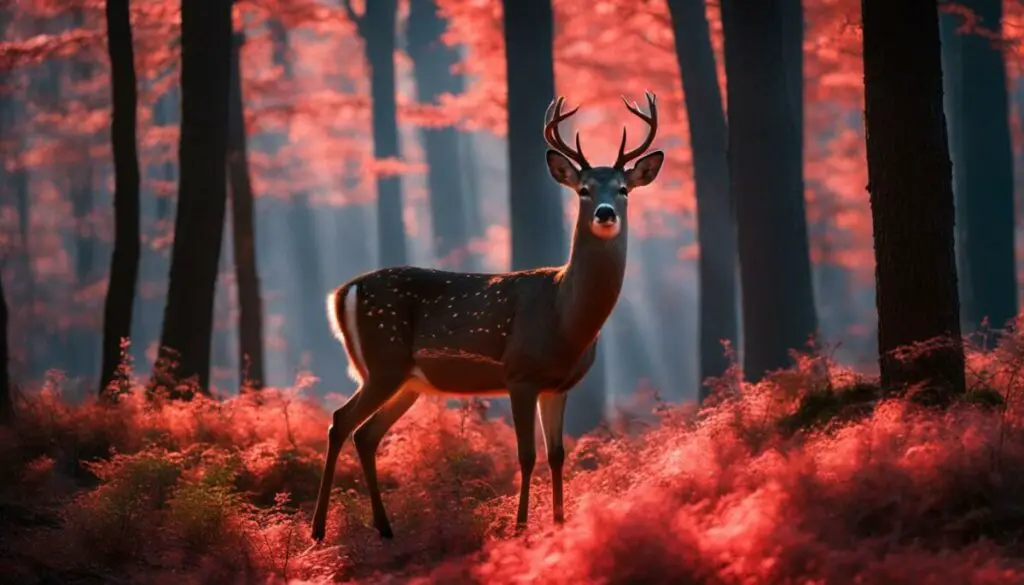
Technological advancements have given us unprecedented insights into the world of wildlife vision. Infrared cameras are a powerful tool for investigating the visual perception of deer and other nocturnal animals in low-light conditions.
Infrared cameras capture images using non-visible wavelengths of light, making them ideal for detecting animals at night or in the dark. These cameras have revealed new information about how deer see the world around them.
One study used infrared cameras to track the movements of deer in a forested area. The cameras revealed that deer were more likely to move in areas where they had cover and could hide from predators. This suggests that deer may rely on visual cues, such as foliage and shadows, to navigate through their environment.
Infrared technology has also been used to investigate whether deer have any adaptations that enhance their ability to detect infrared light. While no conclusive evidence has been found, researchers continue to explore this intriguing topic.
“Infrared cameras have revolutionized our ability to study nocturnal animals like deer in their natural habitats. By capturing images of these animals in low-light conditions, we can gain a better understanding of their visual perception and behavior.”
Future Applications
Infrared technology has the potential to benefit not only wildlife research but also conservation efforts. By understanding how animals see the world around them, we can design more effective strategies for protecting them and their habitats.
For example, infrared cameras could be used to monitor wildlife populations and their movements, providing valuable data for conservationists and researchers. They could also be used to track the spread of invasive species and identify areas where habitat restoration is needed.
“As technology continues to advance, we may discover new applications for infrared cameras in wildlife research and conservation. This exciting field holds immense potential for understanding and protecting the natural world.”
Overall, the use of infrared cameras is a promising avenue for future research into deer vision and their potential to perceive infrared light. By harnessing the power of cutting-edge technology, we can unlock new insights into the mysteries of the natural world.
Debunking Misconceptions
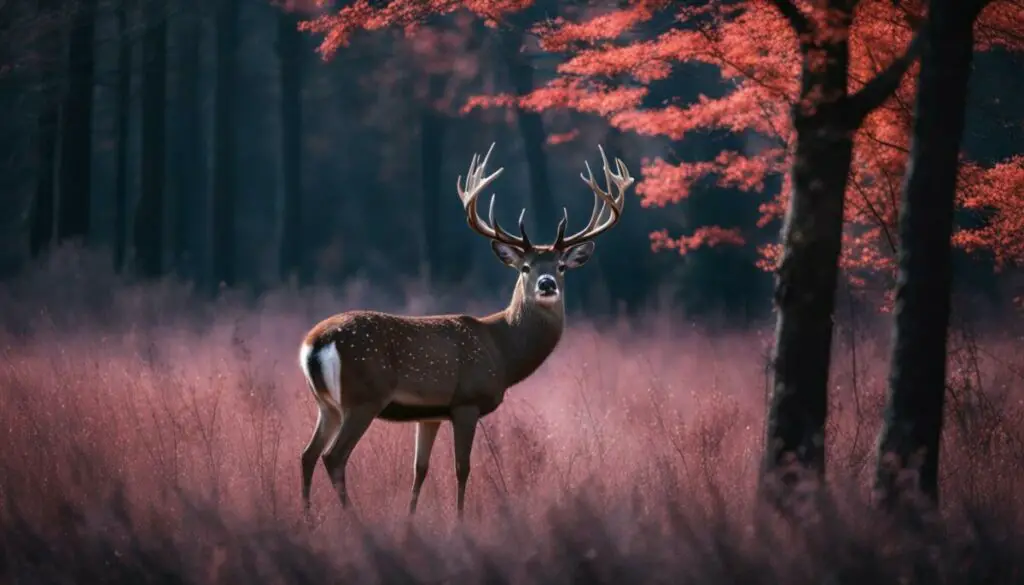
There are misconceptions surrounding deer vision and their ability to see infrared light. One of the most common misconceptions is that deer can see in complete darkness. While it is true that deer have better night vision than humans, they still require some form of ambient light to see. Infrared light, while outside of the visible light spectrum, is still a form of light that requires a source.
Another misconception is that infrared cameras can capture exactly what deer see. In reality, these cameras detect heat signatures and create an image based on those readings. While they can be useful for observing wildlife behavior, they do not provide a complete representation of what deer can see.
“Just because a camera can see something, that doesn’t mean that the animal can see it. The imaging systems we use are based on different principles than the biology of the animal’s eye, so they may not be comparable.”
-Dr. John Porter, Senior Scientist at the Georgia Tech Research Institute
It’s important to separate fact from fiction when it comes to wildlife vision and infrared light. While deer may not have the ability to see infrared light, their visual perception is still a fascinating area of study that can provide valuable insights into the natural world.
The Future of Deer Vision Research
As our understanding of wildlife vision continues to evolve, research on deer and their perception of infrared light is likely to expand. However, there are still many questions to be answered before we can fully comprehend the intricacies of their visual perception.
One avenue for future research could be investigating whether deer possess any adaptations that allow them to perceive infrared light. This could involve examining the structures of their eyes and visual system, as well as studying their behavior in different lighting conditions.
Another area of interest could be exploring the impact of other factors on deer vision, such as environmental factors and camouflage. By understanding how these factors can affect deer’s ability to detect different wavelengths, we may gain a more complete picture of their visual capabilities.
Advancements in technology will undoubtedly play a significant role in future deer vision research. As imaging techniques and equipment continue to improve, scientists may be able to observe and study wildlife vision in even greater detail. Infrared cameras, for instance, could be used to track deer’s visual behavior in the wild, providing valuable insights into their perception of infrared light.
In conclusion, while current scientific evidence suggests that deer do not have the ability to see infrared light, ongoing research may provide new insights and potential discoveries. By continuing to delve into the mysteries of wildlife vision, we may unlock new secrets about the natural world and the fascinating creatures that inhabit it.
Conclusion
In conclusion, the question of whether deer can see infrared light continues to be a fascinating topic of study. Despite ongoing research, the current evidence suggests that deer do not have the visual capability to perceive infrared light.
However, our exploration into deer vision and the characteristics of infrared light has provided valuable insights into the natural world. We now have a better understanding of the light spectrum that deer can perceive and the limitations of their visual perception.
While infrared light detection may not be a feature of deer vision, future research may uncover adaptations that could suggest otherwise. As technology advances and new research emerges, we can continue to expand our knowledge of deer vision and the intricacies of wildlife perception.
Overall, our journey into the mysteries of wildlife vision has been an enriching one. We hope that our exploration into can deer see infrared light and infrared light perception in deer has provided you with a better understanding of the fascinating world of wildlife vision.
FAQ
Can deer see infrared light?
Based on current scientific evidence, deer do not have the ability to see infrared light.
How does deer vision work?
Deer have visual perception that includes a specific range of the light spectrum. They primarily see in shades of blue and green, and their vision is most acute in low-light conditions.
What is infrared light?
Infrared light is a type of electromagnetic radiation that falls outside the visible light spectrum. It has longer wavelengths than visible light and is often associated with heat.
Does infrared light affect deer vision?
While deer cannot see infrared light, it may still have an impact on their visual system. Infrared light can be detected by specialized imaging technology, which researchers use to study deer behavior and monitor their activities.
Are there any scientific studies on deer and infrared light detection?
Yes, researchers have conducted studies to understand how deer perceive different wavelengths of light, including infrared. These studies help contribute to our understanding of deer vision and their sensory capabilities.
Are there any adaptations that suggest deer can perceive infrared light?
No significant adaptations have been discovered in deer that suggest they have the ability to perceive infrared light.
What factors can affect deer’s ability to detect different wavelengths of light?
The structure of deer’s eyes, environmental conditions, and other visual cues in their surroundings can all influence their ability to detect different wavelengths of light.
How have advancements in technology contributed to our understanding of deer vision?
Advanced imaging techniques, such as infrared cameras, have allowed researchers to study deer vision in greater detail. These technological advancements have provided valuable insights into deer behavior and their sensory abilities.
Are there any common misconceptions about deer and infrared light?
One common misconception is that deer can see infrared light. However, scientific evidence suggests otherwise. It’s important to rely on research and factual information when discussing deer vision and their sensory capabilities.
What does the future hold for deer vision research?
As technology advances and research continues, there may be new discoveries about deer vision and their perception of different wavelengths of light, including infrared. Future research may uncover further insights into this fascinating topic.

